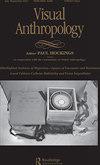Expanded Visions
IF 0.3
Q3 ANTHROPOLOGY
引用次数: 0
Abstract
The dialogues and engagements between the fields of anthropology and contemporary art emerging over the last decades have been increasingly nuanced, provocative and insightful. They are also interestingly elusive. As an anthropologist who has long been drawn to incorporating elements of artistic practice into my own research, I still struggle with defining such work — is it art or anthropology, or something else entirely? For all my efforts to situate my own practice within a distinct disciplinary framework (art – anthropology?), it is still not entirely clear to me how to articulate this framework, where exactly it belongs. Plenty of artists and anthropologists now collaborate or borrow ideas from each other and apply them to their own work, whether this involves filmmaking or exhibition-making or social practice. But most of these projects are still classified ultimately as either art or anthropology, leaving insufficient space to explore the subtleties of their intertwined relationship. Such readings leave these works in a bind: categorized as art, they often are accused of falling short of “ proper ” anthropology; categorized as anthropology, they often are dismissed as bad art. Where is the sweet spot of convergence, that enigmatic ground where both art and anthropology can co-exist, each on their own terms but also in genuine correspondence with one another? The field has now developed to a point where the space between these two arenas has sharper focus but is still in flux, not quite fleshed out to its full potential. Arnd Schneider ’ s most recent book, Expanded Visions , adds another integral component to this evolving scaffolding, examining the configurations of “ consilience ” that arise when these two realms come into contact (a space he refers to as “ art – ethnography ” ). From experimental filmmaking practices to the social dynamics of film production, Schneider engages with a diverse set of examples, delving into the theoretical implications of such work within contemporary anthropology.扩展的愿景
在过去的几十年里,人类学和当代艺术领域之间的对话和互动越来越微妙、富有煽动性和洞察力。有趣的是,它们也难以捉摸。作为一名长期以来一直致力于将艺术实践元素融入自己研究的人类学家,我仍然在努力定义这样的作品——是艺术还是人类学,或者完全是其他什么?尽管我努力将自己的实践置于一个独特的学科框架内(艺术-人类学?),但我仍然不完全清楚如何阐明这个框架,它到底属于哪里。现在,许多艺术家和人类学家相互合作或借鉴思想,并将其应用于自己的作品中,无论是电影制作、展览制作还是社会实践。但这些项目中的大多数最终仍被归类为艺术或人类学,没有足够的空间来探索它们相互交织关系的微妙之处。这样的解读让这些作品陷入了困境:它们被归类为艺术,经常被指责缺乏“适当的”人类学;它们被归类为人类学,经常被认为是糟糕的艺术。融合的最佳点在哪里,艺术和人类学可以共存的神秘地带在哪里,每个人都有自己的条件,但也有真正的对应关系?该领域现在已经发展到这样一个地步,即这两个竞技场之间的空间有了更清晰的焦点,但仍在不断变化,尚未充分发挥其潜力。Arnd Schneider的最新著作《扩展的视野》为这个不断发展的脚手架增加了另一个不可或缺的组成部分,研究了当这两个领域接触时出现的“一致性”的配置(他称之为“艺术-民族志”)。从实验性的电影制作实践到电影制作的社会动态,Schneider列举了一系列不同的例子,深入探讨了这类工作在当代人类学中的理论含义。
本文章由计算机程序翻译,如有差异,请以英文原文为准。
求助全文
约1分钟内获得全文
求助全文
来源期刊

Visual Anthropology
ANTHROPOLOGY-
CiteScore
1.00
自引率
50.00%
发文量
19
期刊介绍:
Visual Anthropology is a scholarly journal presenting original articles, commentary, discussions, film reviews, and book reviews on anthropological and ethnographic topics. The journal focuses on the study of human behavior through visual means. Experts in the field also examine visual symbolic forms from a cultural-historical framework and provide a cross-cultural study of art and artifacts. Visual Anthropology also promotes the study, use, and production of anthropological and ethnographic films, videos, and photographs for research and teaching.
 求助内容:
求助内容: 应助结果提醒方式:
应助结果提醒方式:


